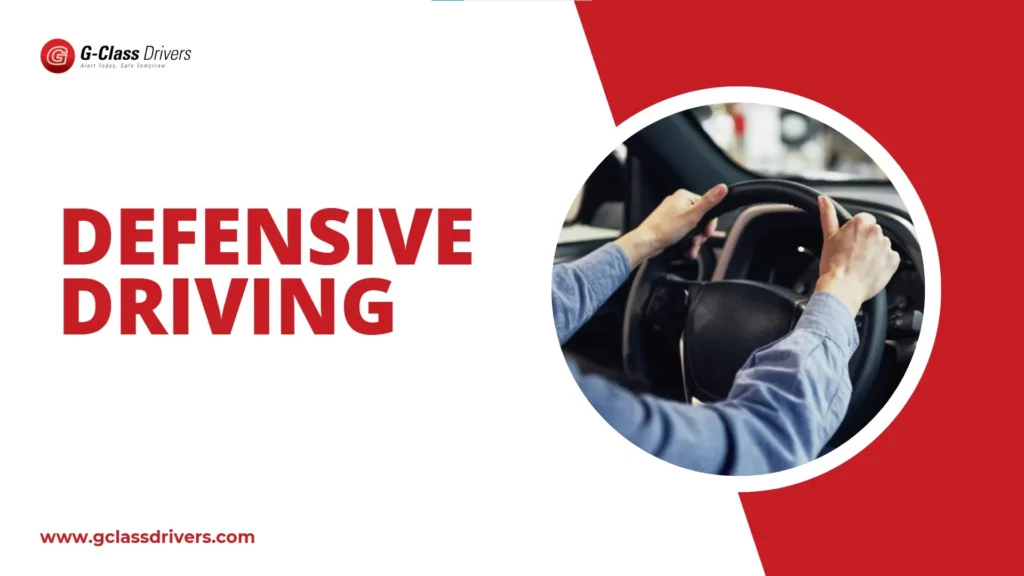Defensive driving is an essential skill for everyone on the road. It’s about predicting and preventing potential dangers and keeping yourself and others safe. In this detailed guide, we’ll explore defensive driving, it’s techniques, explain why it’s critical, and offer simple, practical tips you can apply every time you drive.
What is Defensive Driving?
Defensive driving means being careful and smart while driving. It’s about paying attention to what’s happening around you and being ready for anything unexpected.
This way of driving helps you follow the rules, keep a safe distance from other cars, and avoid accidents. The goal is to stay safe on the road.
Defensive Driving Techniques
Defensive driving is all about staying safe on the road. Here are some key techniques that can help you become a better, more cautious driver.
1. Stay Focused and Avoid Distractions
Keeping your attention on the road is crucial for safe driving.
Eliminate distractions: In our fast-paced world, distractions can be everywhere. Whether it’s using your phone, eating, or adjusting your GPS, these activities can divert your focus from driving. For example, texting while driving increases your crash risk by 23 times.
Mental alertness: It’s essential to control anger while driving. Stress or anxiety can cloud your judgment. Practice staying calm and concentrate solely on driving.
Time management: Before you start your trip, plan. Set your GPS, adjust your mirrors, and select your music beforehand to minimize distractions.
Further Tips:
- Use hands-free devices for calls, but remember that these can also be distracting.
- Take breaks during long trips to remain fresh and alert.
- Avoid multitasking while driving; even a glance at your phone can take your focus away from the road.
2. Keep a Safe Following Distance
Maintaining a safe space between your vehicle and the one in front of you is vital.
The 3-second rule: This simple method helps ensure you’re following at a safe distance. Choose a landmark and, when the car ahead passes it, count to three. If you reach the landmark before the count is complete, you’re too close.
Increase distance in bad weather: In poor conditions, like rain or snow, increase the following distance to five or six seconds to allow for longer stopping distances.
Avoid tailgating: Following too closely not only raises the risk of rear-ending someone but also means you depend on others for your safety. Maintain control by keeping a safe distance.
Further Tips:
- Adjust your speed according to traffic. If someone ahead stops suddenly, having enough space lets you react safely.
- Don’t engage in aggressive tailgating; being too close won’t speed up the car in front.
3. Be Aware of Your Surroundings
Constantly scanning your environment can prevent surprises.
360-degree awareness: Make a habit of checking your mirrors every few seconds to be aware of your surroundings. This practice can help you notice potential hazards, like a car changing lanes or a cyclist approaching.
Blind spot checks: Side and rearview mirrors don’t always show everything. Always look over your shoulder to check your blind spots before changing lanes.
Watch for pedestrians and cyclists: Be especially alert in urban areas, school zones, or near intersections. Slow down and be prepared for sudden movements.
Further Tips:
- Stay vigilant for road hazards, such as construction or animal crossing.
- Anticipate traffic patterns by watching the vehicles ahead of you.
4. Adjust Your Speed for Road and Weather Conditions
Speed should be adjusted based on road, traffic, and weather conditions.
Match your speed to conditions: The posted speed limit is for ideal conditions. In rain or snow, reduce your speed to maintain control, as even light rain can create slippery surfaces.
Cautious on curves and hills: Reducing your speed before entering curves is essential, as going too fast can cause skidding. Be mindful of slower vehicles on hills and adjust your speed accordingly.
Further Tips:
- Slow down at intersections and pedestrian crossings, even if you have the right of way.
- Avoid speeding in poor weather; wet or icy roads can greatly decrease braking effectiveness.
5. Use Signals and Mirrors Effectively
Communicating your intentions helps ensure safety on the road.
Signal in advance: Use your turn signals well before making a turn or changing lanes. This gives other drivers time to react and reduces confusion.
Check mirrors frequently: Regularly glance at your side and rearview mirrors to stay aware of vehicles around you.
Blind spot awareness: Always look over your shoulder to check for vehicles in your blind spot before making any lane changes.
Further Tips:
- Use hand signals if your turn signals are malfunctioning.
- Double-check your surroundings when reversing or parking to avoid low-speed accidents.
6. Be Prepared for the Unexpected
Defensive driving means staying ready for anything.
Expect the unexpected: Whether it’s a driver running a red light or a pedestrian stepping into the road, anticipate that others might make mistakes. This mindset helps you react quickly and avoid accidents.
Have an escape route: Always look for a safe exit while driving. This could be the road shoulder or a clear lane nearby. Knowing your escape options can be crucial in emergencies.
Watch for aggressive drivers: If another driver is speeding or driving erratically, let them pass. Trying to keep up with aggressive drivers increases your crash risk.
Further Tips:
- Keep both hands on the wheel to maintain control of your vehicle.
- Don’t rely on other drivers to follow the rules; always be ready to react.
Defensive Driving Situations
Defensive driving helps prevent accidents by keeping drivers alert and ready for any situation. Here are common situations where defensive driving is essential:
1. Heavy Traffic
In heavy traffic, accidents are more likely. You need to stay calm and keep a safe distance from the car ahead. Be ready for sudden stops or lane changes.
2. Bad Weather
Rain, fog, or snow can make roads slippery. Slow down, increase the following distance, and turn on the headlights. Always be cautious at intersections.
3. Intersections
Intersections are high-risk areas. Slow down as you approach and look both ways. Even if you have the right of way, double-check for cars and pedestrians.
4. Aggressive Drivers
Stay calm when dealing with aggressive drivers. Don’t engage them. Let them pass and maintain a safe distance.
5. Pedestrian Zones
Pedestrians can appear suddenly. Drive slowly near crosswalks and always yield to them.
6. Blind Spots
Always check your blind spots before changing lanes. Use mirrors and glance over your shoulder to ensure no vehicles are in your blind spot.
7. Merging Lanes
When merging, adjust your speed to smoothly join traffic. Watch for other drivers trying to merge.
8. Night Driving
At night, reduced visibility can be dangerous. Use headlights, drive slower, and be on the lookout for hazards or impaired drivers.
Defensive Driving Courses
Defensive driving courses teach safe driving habits. They help you become a more alert and cautious driver. Here’s what you can learn from these courses:
- Courses teach the mindset needed for defensive driving. You’ll learn how to recognize potential hazards and prevent accidents.
- You’ll learn to spot dangers early, whether it’s a distracted driver or a sudden stop ahead.
- Courses cover maintaining safe distances, proper lane changes, and managing speed. You’ll also practice navigating busy intersections and highways.
- Learn how to handle wet or icy roads, fog, or snow. The course teaches how to safely slow down and brake in such conditions.
- You’ll get tips on preventing accidents by anticipating other drivers’ actions and staying alert to your surroundings.
- Courses also cover staying focused on the road. This includes tips for avoiding distractions and managing fatigue.
Why Choose G-Class Drivers?
G Class Drivers offers top-rated defensive driving courses. Our experienced instructors provide practical lessons to help you drive safely in any situation. You’ll learn valuable skills that can reduce your accident risk and improve your confidence behind the wheel.
- Expert Instructors: The school has skilled teachers who know defensive driving well. They give you personal attention and useful tips to help you drive safely.
- Complete Curriculum: The lessons cover everything you need to know about defensive driving. It has a curriculum like spotting dangers, keeping a safe distance from other cars, and ways to avoid accidents. This helps you gain the skills for real-life driving.
- Flexible Learning: G Class Drivers offers different ways to learn, including classroom lessons and hands-on training. This makes it easy for you to learn at your own pace and fit lessons into your schedule.
- Focus on Safety: Safety is the main priority. The school teaches you how to expect and react to possible dangers on the road.
- Supportive Environment: The school creates a friendly and encouraging atmosphere. This quality helps you feel comfortable while learning and makes it easier to remember what you learn.
G-Class Drivers is exceptional for many reasons. They have a proven track record of student success. The school uses modern teaching methods and focuses on individual student needs. They also actively promote safe driving in the community. Choosing G Class Drivers means you’re getting quality training. Your safety is their top priority.
Conclusion
Defensive driving is more than just skills; it’s a mindset. It helps keep you safe on the road. You need to keep a safe distance from other cars and watch what other drivers do. Staying alert and aware of your surroundings lowers risks and leads to safer driving.
At G-Class Drivers, we offer defensive driving courses. Our programs teach you the skills you need to drive safely. Whether you are new to driving or want to improve your skills, our friendly instructors are here to help.
Sign up today and become a safer driver! Visit G Class Drivers and join our defensive driving program now!
FAQs
What are characteristics of a defensive driver?
A defensive driver is alert and proactive. They pay close attention to their surroundings, anticipate potential hazards, and make decisions that prioritize safety. This includes maintaining a safe following distance, using mirrors effectively, and adjusting their speed based on road conditions.
Which ability is most important to safe defensive driving?
The most crucial ability for safe defensive driving is situational awareness. This means constantly scanning the environment for potential risks, such as pedestrians, other vehicles, and changing traffic conditions. Being aware allows drivers to react appropriately to unexpected situations.
Who is a good defensive driver?
A good defensive driver is someone who demonstrates responsible driving behavior. They follow traffic laws, remain calm in stressful situations, and adapt to changing road conditions. They also prioritize safety for themselves and others on the road.
What are the three main principles of defensive driving?
The three main principles of defensive driving include:
- Awareness: Always be conscious of your surroundings and the behavior of other drivers.
- Space Management: Maintain a safe following distance and ensure adequate space around your vehicle.
- Speed Control: Adjust your speed based on traffic, road conditions, and weather.
What is the best defensive driving technique?
The best defensive driving technique is to expect the unexpected. This involves preparing for sudden changes in traffic, such as another driver running a red light or a pedestrian stepping into the road, and being ready to react quickly
What are the seven keys to safe driving?
The seven keys to safe driving include:
- Stay focused and avoid distractions.
- Keep a safe following distance.
- Be aware of your surroundings.
- Adjust your speed for road and weather conditions.
- Use signals and mirrors effectively.
- Be prepared for the unexpected.
- Maintain a calm and patient attitude





